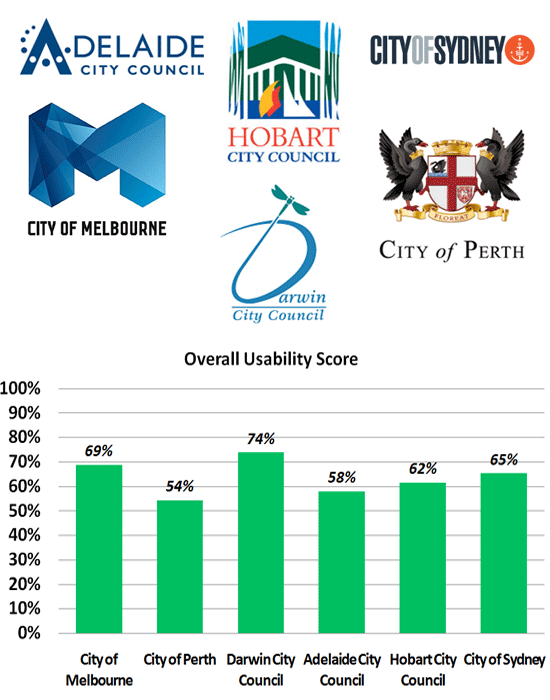
Which City Council has the best website?
We took six of Australia’s capital city councils and tested the usability of their websites. You'll be surprised by which council came out on top.
Understand user behavior on your website.
Test usability on mobile devices and tablets.
Conduct live, guided user testing sessions.
Design or refine your information architecture.
Allow users to test without assistance.
Understand visitors’ goals and satisfaction.
Determine which design performs better.
Analyze your website against competitors.
Optimize design before development.
Measure ease of finding your online properties.
Gain deeper insights using the power of AI.
Track users’ clicks and navigation patterns.
Visualize user engagement and interaction.
Capture user interactions for usability analysis.
Get access to all Loop11 features for free. Start free trial
Understand user behavior on your website.
Test usability on mobile devices and tablets.
Conduct live, guided user testing sessions.
Design or refine your information architecture.
Allow users to test without assistance.
Understand visitors’ goals and satisfaction.
Determine which design performs better.
Analyze your website against competitors.
Optimize design before development.
Measure ease of finding your online properties.
Gain deeper insights using the power of AI.
Track users’ clicks and navigation patterns.
Visualize user engagement and interaction.
Capture user interactions for usability analysis.

Diverse user testing methods for true user understanding.

Uncover user motivations and goals for resonant experiences.

Align strategies with user motivations for better returns.

True intent studies involve a range of methodologies, each designed to unravel specific user behavior and preferences. By combining various approaches, you can gain comprehensive insights into user intent and make data-driven improvements on your website. Here are the six types of true intent user testing you can perform with Loop11:

Engage users during specific points in their session to gather feedback on product aspects or the overall experience. Through a perfectly-timed pop-up survey, you can invite your website visitors to share their purpose for visiting and rate their satisfaction.

Capture valuable feedback from users attempting to leave your website, understanding their reasons and uncovering any encountered issues.

Set specific goals for participants to complete on your website, revealing usability issues and areas of confusion. Through screen recordings or live sessions, you can witness firsthand how users navigate your website.

Ask for user feedback on the clarity of your site navigation and user interface by guiding participants through predefined paths, identifying any encountered difficulties.

Track and analyze user click patterns, allowing you to gain insights into user journeys, identify popular paths, and optimize website flow.

Visualize user click interactions on desktop, tablet and mobile through aggregated data to identify behavior patterns, areas of interest, and optimize important elements.

With true intent studies, you can gain valuable insights by inviting users to share their purpose for visiting and rate their satisfaction at each stage of your customer funnel.
A true intent study is an effective way of gathering insights to help you uncover your users’ intentions in real-time and gain a deeper understanding of what motivates your users to take action or frustrations they encounter. Here are the benefits of conducting true intent user research:

Gain an understanding of why users visit your website or use your app. Discover their motivations, goals, and intentions, allowing you to create a user-centric website that delights and aligns your offerings with their needs.

Track how users navigate and accomplish tasks on your site, identifying areas that need improvement. With these smart insights, you can prioritize optimizations for seamless user journeys and exceptional experiences.

Uncover the most effective ways for users to achieve their goals on your website. By improving usability and findability, you ensure that users can easily navigate and locate desired information or products, increasing their satisfaction.

Analyze user behavior and preferences at each stage of the conversion funnel. Find the barriers that prevent users from completing desired actions, and optimize your funnel to drive higher conversion rates.

Craft targeted content and messaging that resonates with your audience. By understanding user intent, you can deliver personalized experiences that capture their attention and drive engagement.

When users find what they’re looking for effortlessly, it enhances their perception of your brand. True intent studies help you build an intuitive, user-friendly experience that fosters positive brand associations and cultivates customer loyalty.


“We really wanted to capture those little bits of feedback that you can only discover when users are in the middle of doing something on the app: when they’re frustrated by something, surprised by something, or when they like something or find something particularly entertaining.”


“Using Loop11 allows us to deliver quantitative data so the client can see where the painpoints of their users are and where to tackle the usability issues in their platform.”


“Inviting stakeholders to watch the live sessions is super powerful because it helps them to empathize with users firsthand. We’re also able to put their assumptions to the test.”

Explore our features that allow you to easily manage your testing projects and obtain valuable feedback from your users.
Understanding user behavior on your website is essential for improving user experience and boosting conversions. Unlike traditional surveys, true intent studies’ innovative approach captures real-time insights to help you uncover your users’ intentions and gain a deeper understanding of what drives your users to take action. Doing so will help you optimize their experience, leading to better user satisfaction and engagement.
A recent survey on intent data trends by Demand Science revealed that 16% of respondents have seen a 70% (and more) increase in conversion rate with leads generated from intent data. The potential impact on your bottom line far outweighs the cons!
Strategically asking targeted questions as users enter and exit your website is an art and a science. If done right, you can unveil a treasure trove of data that explores their intentions, preferences, and satisfaction with every click. You can pinpoint areas for improvement and watch your website flourish with clarity and purpose.
Imagine learning the hurdles an eager shopper faces during the checkout process. Armed with this knowledge, you can make improvements for a better experience that will lead to higher conversion rates. This is just one of the many benefits of a true user intent study that a website owner or a marketer can take advantage of.
At Loop11, we help you embrace the power of true user intent studies that will meet and exceed user expectations. So get ready to dive into the minds of your users, elevate your digital presence, and connect with them on a deeper level that you haven’t explored before.
User intent lies at the heart of understanding user needs and providing a seamless user experience. However, this task has its challenges:
Users sometimes explicitly express their intent, making it harder to discover their motivations. User actions such as clicks or page visits might not clearly indicate their goals or needs. To deal with this challenge, advanced techniques like Natural Language Processing (NLP) and sentiment analysis can be used to gain deeper insights from user interactions.
User intent is often multi-dimensional, a mix of goals, desires, and preferences. Identifying and interpreting these layers of intent behind a user's actions can be challenging. Machine learning algorithms, such as clustering and classification models, can help unveil the intricate web of user intent, allowing more precise understanding and prediction.
User intent can change over time or within different contexts. In addition, users' goals and motivations may shift, requiring strategies to continuously reassess and adapt. By conducting regular user research studies and monitoring user behavior patterns, you can follow user intent and proactively adjust to align with user needs.
Limited data about users' demographics, previous interactions, or external factors hinder accurate intent determination. This challenge involves better data collection methods, advanced analytics tools, and leveraging user profiling techniques to gain deeper contextual insights.
Each user is unique, and their intent can be influenced by personal preferences, cultural backgrounds, or browsing habits. The biggest mistake of them all is to generalize user intent. Applying segmentation and personalization techniques can help categorize users into specific groups, allowing for more tailored approaches.
Acquiring complete data about user intent can be challenging due to limited access to user information, data privacy policies, or inadequate tracking and analytics tools. Investing in robust data collection mechanisms, user feedback channels, and analytics platforms to address this issue can provide a more holistic view of user intent.
Users may not always want to provide explicit feedback or conduct surveys or interviews. This limits the direct feedback available to understand their intent. Relying solely on passive observation or indirect indicators can introduce uncertainty in determining user intent. To address this, employ user-centered design principles, conduct usability testing, and encourage user feedback through intuitive interfaces.
Determining user intent is a complex endeavor, but combining techniques such as analyzing user behavior patterns, user research studies, and leveraging machine learning algorithms can gain deeper insights into user intent.
To conduct a true user intent study, follow these steps:
Step 1: Seize Users
To collect data from your website visitors, it is vital to stop them with a survey invitation as they enter and leave your site. This can be achieved with pop-ups or embedding JavaScript into your web pages. The goal is to prompt users to participate in the study and gather feedback.
Step 2: Ask Questions Upon Entry
Once users agree to participate, asking them a few questions is crucial to gather information about their intentions and expectations. These questions serve as a starting point for understanding user behavior and motivations. Some examples:
Step 3: Ask Questions Upon Exit
After users have completed their visit, it is essential to ask them a few more questions to learn their level of satisfaction and success in achieving their goals. These exit questions help evaluate the overall user experience and identify areas for improvement. Some examples:
Step 4: Ask Questions Upon Entry
After collecting responses from your website visitors, it is crucial to analyze the data to identify trends, patterns, and areas of improvement. This analysis involves looking for common issues or roadblocks that hinder users from achieving their goals. Then, by prioritizing optimizations based on the identified trends, you can make targeted improvements to align with their intentions and expectations.
By following these steps, you can conduct a thorough user intent study that provides valuable insights into user behavior, motivations, and areas for improvement, ultimately helping you create a better user experience on your website.
True user intent studies can be applied in various scenarios, including:
Understanding user motivations: A true user intent study can help you better understand why users visit your site. By asking entry questions such as "Why did you come to the website today?" or "What are you looking to achieve?", you can uncover the motivations and goals of your users.
Evaluating task success: With a user intent study, you can assess whether visitors can successfully accomplish their desired tasks on your site. By asking exit questions like "Was your visit successful?" or "Were you able to find what you were looking for?", you can gather insights into the usability and effectiveness of your website in fulfilling user needs.
Prioritizing improvements: A user intent study can provide valuable input for prioritizing website improvements. By analyzing the collected data and identifying common issues or roadblocks users face, you can determine the most critical areas that need attention. For example, if many users struggle to find specific information, you can prioritize optimizing the site's search functionality or improving the information architecture.
Validating design changes: If you plan to make significant design changes to your website, conducting a user intent study beforehand can help validate those changes. By gathering user feedback on their expectations and perceptions of the existing design, you can assess the potential impact of the proposed changes. This can prevent unnecessary redesigns that may not align with user preferences.
Optimizing conversion funnels: A user intent study can also be beneficial for optimizing conversion funnels on your website. By understanding the motivations and intentions of users at different stages of the funnel, you can identify areas where users may be dropping off or encountering difficulties. This insight allows you to refine the user journey, address friction points, and improve the conversion rate.
Here are four things to keep in mind when running user intent research:
Google's EAT (Expertise, Authoritativeness, Trustworthiness) guidelines play a significant role in understanding user intent. High-quality content that sticks to EAT guidelines will likely satisfy user needs and expectations.
To create content that aligns with user intent, focus on the expertise, authoritativeness, and trustworthiness of the information you provide. Ensure that your content is written by knowledgeable authors, backed by credible sources, and delivers value to your users.
You can tailor your user intent study to suit user needs and preferences. For example, you can adjust the survey duration, target specific user segments, or display the survey only during peak traffic times.
By customizing your study, you can gather more accurate and relevant data to help you make informed decisions about your website's optimization.
Polysemous words, or words with multiple meanings, can pose challenges in user intent research. For instance, a search query for "apple" could refer to the fruit or the technology company, making it challenging to discern user intent.
Each user is unique, and their intent can be influenced by personal preferences, cultural backgrounds, or browsing habits. The biggest mistake of them all is to generalize user intent. Applying segmentation and personalization techniques can help categorize users into specific groups, allowing for more tailored approaches.
To overcome this challenge, consider the search query's context and analyze additional data, such as user demographics and browsing behavior, to better understand the user's true intent.
To effectively cater to user intent, it is vital to empathize with your website visitors and see things from their perspective. Try to imagine yourself as a user navigating your site, and ask yourself:
Also, consider running usability tests to gather unbiased insights into your site's user experience.
Implementing a user intent research strategy will improve your website's performance and contribute to building a solid and loyal customer base. So, start exploring the world of true user intent and unlock the potential of your website today!

We took six of Australia’s capital city councils and tested the usability of their websites. You'll be surprised by which council came out on top.

We are thrilled to announce a major update to Loop11 - the AI Summaries feature. This new product update will revolutionize the way UX researchers analyze user research data, making their work faster, more efficient, and more insightful. This feature is a game-changer for UX research and we are proud to be the first UX platform to offer it. We encourage you to try it out and see the difference it makes in your work.

In the field of User Experience (UX) design, understanding the principles of visual hierarchy is incredibly important. By carefully arranging elements, colors, and content, visual hierarchy acts as a guiding tool, making it easier for users to navigate and accurately gather information. This blog takes a deep dive into the concepts that lead to effective […]
Start running true intent user studies today and unlock the power of understanding your users on a deeper level with Loop11.

We love sharing interesting UX topics and work by creatives out there. Follow us for weekly UX posts, inspirations and reels!